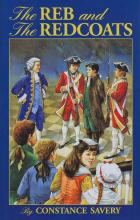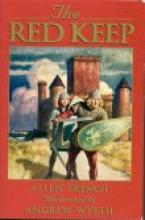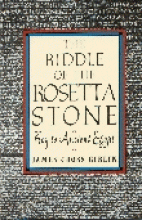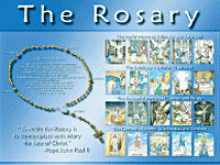No name
The Reb and the Redcoats
The Reb and the Redcoats is an adventurous historical fiction story about a British family during the American Revolution who "play host" to an American prisoner of war. 15 year old Randal is a well-educated Virginian who was sent on a military mission as a French interpreter. When he and his comrades are captured, he gives his captors no end of trouble with his escape attempts and is finally confined to an old penance cell at the estate of Laurence Templeton (which had once been a monastery). Things get interesting when Captain Templeton's elder sister, Mrs. Darrington and her four children arrive for an indefinite stay at the estate. The children are fascinated by the American Rebel and can't understand why Uncle Laurence is so resentful of his presence.
This is one of the most delightful stories I've read in a long time. Although it is recommended for ages 10 and up, our entire family enjoyed this story immensely. Not only is it a very enjoyable and well-told tale (with accurate historical details), but there are some very nice lessons tied into the story about how we should treat other people and how easy it is to misjudge.
The Red Falcons of Tremoine
Suitable for ages 10 and up.
The Red Keep
Fifteen year old Conan is training for the knighthood and witnesses the Sauval firsthand as they plunder a neighboring castle. He rescues the only survivor of the family, their daughter Anne. She is taken in by the family that Conan is staying with.
By the time he is 20, Conan's father and brother have been killed by the Sauval. Anne tries to convince him that the Sauval will continue to strike his family, thus improving their position in the area, but Conan doesn't believe her until another brother is killed. Finally, determined to return the Red Keep to its rightful owner, Conan vows to avenge his losses and to stop the Sauval brothers from taking permanent control of the countryside.
His journey takes him to Vezeley to gather information from the Lord Abbot who secretly supports the Sauval. Here, Conan sacrifices his dignity by cutting his long hair, a sign of his rank in society, and learning the ways of the masons. He works alongside the masons as they do repair work for the abbot and is able to eavesdrop on the abbot and his men. The abbot then asks Conan and the masons to rebuild the Red Keep for the Sauval brothers. Conan convinces the masons to do the work, not for the abbot, but so that Anne can claim the Red Keep for herself. The plans and resulting battle make for a fast-paced, suspense-filled story.
The Red Keep is great reading for boys and girls. It's full of plenty of action and there is a subtle romantic storyline wound through. Allen French has created a believable main character that shows human weakness, yet is cunning and thoughtful at the same time. He has Conan realistically growing from a proud, rash youth into a loyal, kind man. All this occurs in 12th century France, which gives the reader a detailed picture of medieval life and the feudal system.
I agree with Bethlehem Book's recommendation of a reading age of 10 and up since the book contains some fairly violent scenes.
Reviewer age 13
The Red Letter Alphabet book
Pages are made of heavy cardstock
The Reed of God
Sometimes it may seem to us that there is no purpose in our lives, that going day after day for years to this office or that school or factory is nothing else but waste and weariness. But it may be that God has sent us there because but for us Christ would not be there. If our being there means that Christ is there, that alone makes it worthwhile. (pg. 60)
We must be swift to obey the winged impulses of His Love, carrying Him to wherever He longs to be; and those who recognise His presence will be stirred, like Elizabeth with new life. They will know His presence, not by any special beauty or power shown by us, but in the way that the bud knows the presence of the light, by an unfolding in themselves, a putting forth of their own beauty. It seems that this is Christ’s favourite way of being recognised, that He prefers to be known, not by His own human features, but by the quickening of His own life int he heart, which is the response to His coming. (pgs. 62-63)
If such is the beauty of the world to ordinary children, what must it have been to the Mother of God, when her whole being was folded upon the unborn Christ within her? He was completely her own, utterly dependent upon her: she was His food and warmth and rest, His shelter from the world, His shade in the Sun. She was the shrine of the Sacrament, the four walls and the roof of His home. Yet she must have longed to hold Him between her hands and to look into His human face and to see in it, in the face of God, a family likeness to herself Think of that! But perhaps you cannot, unless you happen to be a young priest newly ordained, waiting for the moment when you will hold in your hands the first Host that you have consecrated at your first Mass. … Each work of her hands prepared His hands a little more for the nails; each breath that she drew counted one more to His last. In giving life to Him she was giving Him death. All other children born must inevitably die; death belongs to fallen nature; the mother’s gift to the child is life. But Christ is life; death did not belong to Him. In fact, unless Mary would give Him death, He could not die. Unless she would give Him the capacity for suffering, He could not suffer. He could only feel cold and hunger and thirst if she gave Him her vulnerability to cold and hunger and thirst. He could not know the indifference of friends or treachery or the bitterness of being betrayed unless she gave Him a human mind and a human heart. That is what it meant to Mary to give human nature to God. He was invulnerable; He asked her for a body to be wounded. He was joy itself; He asked her to give Him tears. He was God; He asked her to make Him man. He asked for hands and feet to be nailed. He asked for flesh to be scourged. He asked for blood to be shed. He asked for a heart to be broken. (pgs. 72-73)
If Christ is formed of our lives, it means that He will suffer in us. Or, more truly, we will suffer in Him. “And He was made man.” Our Lady saw at once what was meant in her case: supernaturally, He was made herself. If He is made man in you, He will be made you; in me, me. It is extremely difficult to lay hold of this fact. It is very hard not to think of a kind of mystical Christ just beside us, or just in front of us, suffering with infinite patience and joy, being obedient, humble, persevering, fulfilling His Father’s will. It is really difficult to realise that if He is formed in our life we are not beside Him but in Him; and what He asks of us is to realise that it is actually in what we do that He wants to act and to suffer. (pgs. 76-77)I read this on retreat about a month ago (a silent, Ignatian retreat and my first retreat in 20 years – it was wonderful!) because my spiritual director had recommended it and I loved how perfectly it tied into the talks on the spiritual exercises and the book I happened to be reading alongside it – Does Jesus Know Us? Do We Know Him? by Hans Urs Von Balthasar.
The Restoration of Christian Culture
This book, originally published by Ignatius Press (with ecclesiastical approval) is available in print once again from Roman Catholic books. John Senior, an eminent great books scholar and Catholic writer of the recent past, here addresses what Christian Culture is, why it has nearly disappeared (particularly in America today) and what is required to bring it back. According to Professor Senior, society's removal from nature and manual labor, and particularly our heavy dependence on technology, have removed man from the most basic processes of learning and understanding that God planned for man to acquire by his natural surroundings. Humanistic philosophies are rooted in an emphasis on the greatness of man and his "creations" (i.e. technology) rather than glorying in God's Creation. According to Mr. Senior, a truly Christian culture requires a return to a basic understanding of the "stuff of life" by a far lessened and more controlled use of technology and other changes such as a return to the beauty and truth of the liturgy as it was celebrated in the past (the author respectfully argues that the traditional Latin Mass is a superior alternative to the Novus Ordo as it has commonly been implemented in the U.S. since Vatican II).
Even if you find his contempt for modern technology somewhat extreme, I would recommend reading his ideas in order to make yourself aware of how significantly our lives are impacted by technology today. Although it's not often talked about, I think it's vitally important for parents to understand that the problems with television for children go beyond simple concerns with regard to morally offensive content. People were not designed to sit in front of a box (be it a computer or a television). Although movies and computer games can enhance a child's education, they should be used in moderation or avoided. (You may also be interested in following this link in order to read Pope John Paul II's address on Television and the Media.
The author also addresses, in some detail, certain educational philosophies from a Catholic perspective. In particular, parents may find interesting a discussion of what literature is appropriate for Catholic children to read. I was particularly fascinated by his discussions of St. Benedict and traditional monastic life. I've always had a certain admiration for and interest in the idea of cloistered life (and even more so since reading Saint Benedict by Mary Fabyan Windeatt). I would like in some way to imitate the order, the motto of oro et laboro (I pray and I work) and the genuine sense of community within my own family. But I digress...
His remedy, involving a certain amount of good old-fashioned common sense and a return to a simpler life, is crowned by a rather splendid explanation of the necessary and central role of a return to a culture of Mary, the Mother of God and a strong devotion to her. He explains how this would be in imitation of the devotion of those simple people of the Middle Ages who spent their lives working to honor God through his Blessed Mother with beautiful cathedrals and artwork. The author contrasts this with the modern humanistic focus (if not "worship") of man-made objects (technology) which often reach no higher than utility and a glorification of what man can do.
I found this book surprisingly readable and delightfully filled with truth. Although parts of the book have a somewhat pessimistic flavor (and I don't agree with absolutely everything in the book), this is always tempered with a proper sense of hope and trust in God's providence. As a point of interest, John Senior's philosophies were apparently quite influential in the development of two of today's Catholic homeschool programs - Kolbe Academy and the Angelicum Academy.
The Riddle of the Rosetta Stone
The study of Ancient Egypt seems to be of great interest to children. I imagine that this is largely due to the pyramids (and other monuments) and the large quantity of strange and colorful artifacts that exist. A good study of this subject can lead to a greater understanding of how we learn about the past, the purpose and workings of archaeology and the "theatre" in which God chose to perform his spectacular display of signs and wonders which culminated in the Exodus of the Israelites from Egypt.
This book could play a useful role in such a study by explaining how modern man has come to learn about Egypt as well as presenting an introduction to how hieroglyphics work (another topic which children seem to be fascinated by).
Illustrations include sketches of Egyptian scenes dating form the 18th and 19th centuries (A.D.), black and white photos of Egyptian artifacts, and simple reproductions of hieroglyphs being discussed. The text includes a translation of the Rosetta Stone. Reading level is approximately 4th grade and up (could also be read-aloud to younger children).
includes index and bibliography
The Rosary (Wall Chart)
This simple wall chart offers colorful pictures for each mystery of the Rosary (Joyful, Luminous, Sorrowful and Glorious are included) along with an illustrated explanation of how to say the Rosary. Each mystery of the Rosary is labeled along with which days of the week to say each set of mysteries.
My children love having this chart on their bedroom wall where they listen to the Rosary on Catholic Radio at night. The pictures have really helped them in visualizing the mysteries and in getting a better understanding of the Life of Jesus.
On the back of the chart you will find four reproducible worksheets - a listing of the Mysteries of the Rosary with Biblical references, "Prayers of the Rosary", a reproduction of the chart itself and "How to Pray the Rosary"
19 3/8" x 26" poster (available laminated or unlaminated)
The Rosary is Alive
Also available in Large Print and Spanish Large Print editions.










